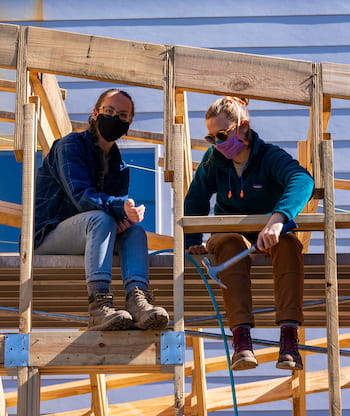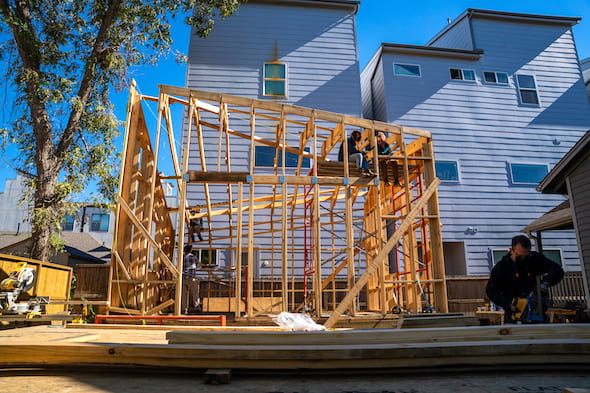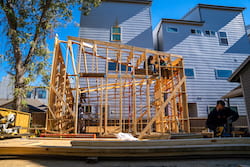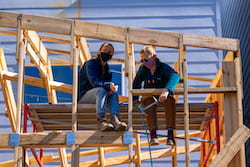NEWS RELEASE
Jeff Falk
713-348-6775
jfalk@rice.edu
Mike Williams
713-348-6728
mikewilliams@rice.edu
Rice Architecture students design Texas-style accessory unit for Houston’s First Ward
HOUSTON – (Dec. 14, 2020) – A new small home designed and being built by Rice University students divides to conquer in the quest for energy efficiency.
The Auxiliary ADU (accessory dwelling unit) under construction in Houston’s northwest-of-downtown First Ward is a house in two parts, with a living room and kitchen on one side, a bedroom and bathroom on the other and a Texas-style “dogtrot” breezeway that separates the two.
When either side is in use, energy usage can be minimized in the other. Solar panels on top will produce enough electricity to run the 600-square-foot house, making it truly net-zero.
The latest project by design-and-build workshop Rice Architecture Construct has been in the works for more than a year, beginning with a design by graduate student Kati Gullick and alumna Madeleine Pelzel in the fall 2019 Totalization Studio taught by Andrew Colopy, an assistant professor of architecture and Construct co-director.
With a $50,000 grant from Rice’s Energy and Environment Initiative, and in collaboration with Dominic Boyer, a professor of anthropology, the Center for Energy & Environmental Research in the Human Sciences and the ultimate owner, the community development organization Avenue CDC, students and volunteers are now framing the house with a goal of enclosing as much of it as possible before the holiday break. Interior and exterior finishing will continue in the spring, with a goal to complete the project next summer.

Rice Architecture students Alex Oetzel, left, and Claire Wagner work on framing of the Auxiliary ADU under construction in Houston’s First Ward. The small house will be energy-independent, with solar panels and a breezeway that separates two living spaces. Photo by Brandon Martin
Aside from being a perfect spot to relax outside in the shade, the dogtrot is key to balancing the dwelling’s energy profile. “It induces flow,” said Construct co-director Danny Samuels, a professor in the practice of architecture. “Basically, when a building blocks the air stream, you have a plus pressure side and a negative pressure side. By opening up space between the two, that pressure pulls air through the house and through the rooms.”
Gullick and Pelzel consulted with structural engineers Pat Arnett and Greg Koch of Robert Silman Associates and mechanical, electrical and plumbing engineer Ben Wylie of Wylie Consulting Engineers as they developed their construction plans.
Both students are now onsite, tools in hand, along with classmates and volunteers building the structure behind housing also owned by Avenue CDC. “It creates more density in Houston without destroying the existing fabric,” Gullick said. “It’s not only energy-efficient, it will also have a photovoltaic array on the roof and will create its own electricity.”
Colopy noted Joey Romano of Local Sun/Mobile Grid and Rice alumnus Joe Meppelink of Metalab/Mobile Grid are industry partners on the project, providing expertise in the solar and battery technology that will give the home its smarts.
“Theoretically, when the battery is in place, smart systems like modern thermostats will learn how you use the building and minimize energy usage automatically,” Samuels said. “You won’t even have to think about it.”

Rice Architecture students are building an accessory dwelling unit in Houston’s First Ward with a uniquely southern feature — a dogtrot — that will help give the building net-zero energy status. Photo by Brandon Martin
“It’s always a learning experience, every job site is a little bit different,” said graduate student Alex Oetzel, who is in her last semester at Rice and whose family is in construction. “This one in particular is very small and yet very technical and precise. I can’t say that in my past experiences I constructed a home or any structure that’s been quite so precise.”
The project continues a thread that began with Construct’s predecessor, the Rice Building Workshop, to produce the ZeRow House that competed in the Department of Energy’s Solar Decathlon and was ultimately installed in Houston’s historic Third Ward, the ModPod prefabricated residential core, and the +House built in the Third Ward in 2018.
-30-
Follow Construct on Instagram at https://www.instagram.com/rice.construct/?hl=en.
Follow Rice News and Media Relations via Twitter @RiceUNews.
Related materials:
Rice Construct: https://arch.rice.edu/facets/construct
Construct projects: https://arch.rice.edu/projects/construct
Rice Architecture: https://arch.rice.edu//
Video:
Video produced by Brandon Martin/Rice University
Images for download:
https://news2.rice.edu/files/2020/12/1214_CONSTRUCT-1A-WEB.jpg
Rice Architecture students are building an accessory dwelling unit in Houston’s First Ward with a uniquely southern feature — a dogtrot — that will help give the building net-zero energy status. (Credit: Brandon Martin/Rice University)
https://news2.rice.edu/files/2020/12/1214_CONSTRUCT-2-WEB.jpg
Rice Architecture students Alex Oetzel, left, and Claire Wagner work on framing of the Auxiliary ADU under construction in Houston’s First Ward. The small house will be energy-independent, with solar panels and a breezeway that separates two living spaces. (Credit: Brandon Martin/Rice University)
Located on a 300-acre forested campus in Houston, Rice University is consistently ranked among the nation’s top 20 universities by U.S. News & World Report. Rice has highly respected schools of Architecture, Business, Continuing Studies, Engineering, Humanities, Music, Natural Sciences and Social Sciences and is home to the Baker Institute for Public Policy. With 3,978 undergraduates and 3,192 graduate students, Rice’s undergraduate student-to-faculty ratio is just under 6-to-1. Its residential college system builds close-knit communities and lifelong friendships, just one reason why Rice is ranked No. 1 for lots of race/class interaction and No. 1 for quality of life by the Princeton Review. Rice is also rated as a best value among private universities by Kiplinger’s Personal Finance.




